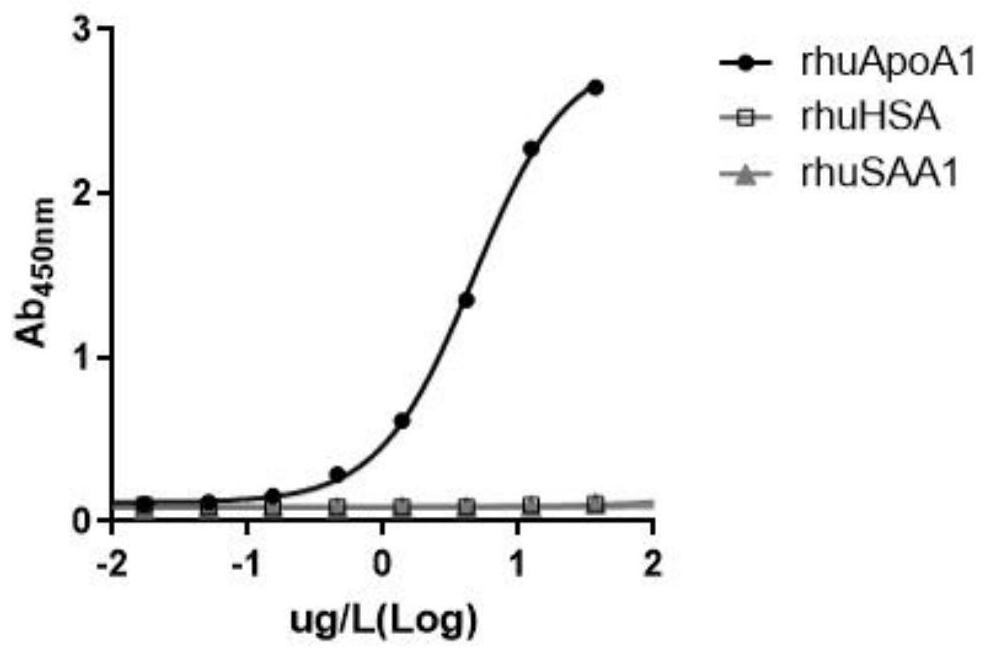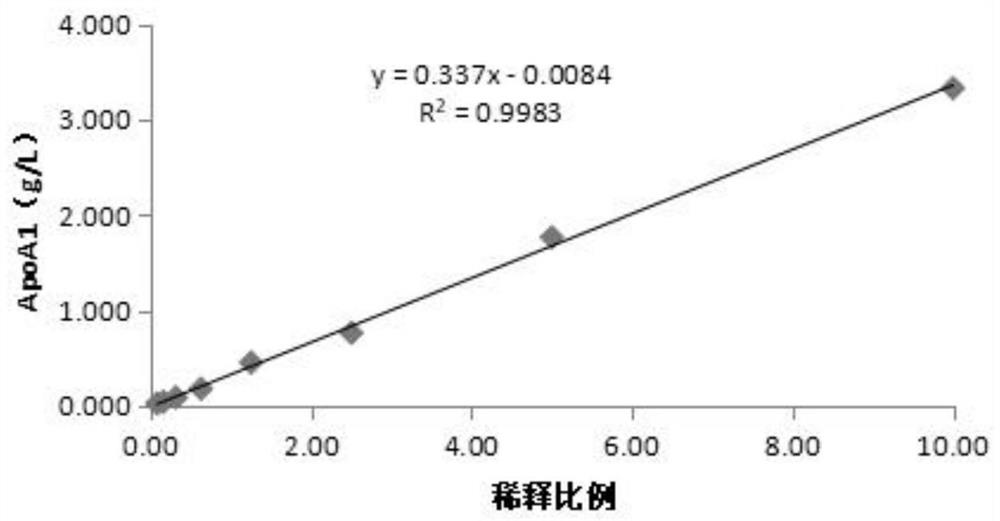Anti-human ApoA1 monoclonal antibody for identifying HDL subclass in positive correlation with coronary heart disease and preparation and application thereof
A monoclonal antibody, cardiovascular and cerebrovascular disease technology, applied in the fields of application, botany equipment and methods, biochemical equipment and methods, etc., can solve the problem of inability to integrate, complicated and time-consuming operation, and failure to meet the needs of rapid and high-throughput clinical testing and other issues to achieve the effect of improving the consistency rate, high affinity and specificity
- Summary
- Abstract
- Description
- Claims
- Application Information
AI Technical Summary
Problems solved by technology
Method used
Image
Examples
Embodiment 1
[0042] Example 1: Preparation and purification of ApoA1 monoclonal antibody D11-6
[0043] 1. Materials: fusion protein 6×His-ApoA1, 8-week-old female BALB / c mice
[0044] 2. Methods and Results
[0045] 2.1 Antigen preparation
[0046] 2.1.1 Construction of human ApoA1 recombinant protein expression plasmid
[0047] The gene sequence (Gene ID: 335) of ApoA1 was obtained by querying in GenBank, and polymerase chain reaction (PCR) primers were designed according to the sequence. The DNA fragment of human ApoA1 gene was amplified using human cDNA as a template. The PCR product was detected by 1.0% agarose gel electrophoresis and the corresponding fragment was recovered with a gel recovery kit. The size of the ApoA1 gene fragment amplified by PCR was 875bp. The PCR product was ligated into the expression vector pCold TM II (the 6×His tag contained in the vector is used for purification), transformed into TaKaRaDH5α host bacteria, picked a single clone for plasmid extraction a...
Embodiment 2
[0065] Example 2: Determination of the variable region sequence of ApoA1 monoclonal antibody D11-6
[0066] 1. Materials: Trizol (Invitrogen), primers were synthesized by Sangon Bioengineering Company, reverse transcription and PCR reagents were purchased from TaKaRa Company.
[0067] 2. Methods and results:
[0068] 2.1 Total RNA extraction and cDNA first-strand synthesis
[0069] The hybridoma cells in the logarithmic growth phase were collected, and total RNA was extracted according to the operating procedure of the Trizol manual. The qualitative and quantitative identification of total RNA was performed using a spectrophotometer and agarose gel electrophoresis.
[0070] According to TaKaRa PrimeScript TM II 1st Strand cDNA Synthesis Kit Instructions Synthesize cDNA.
[0071] 2.2 Amplification and sequencing of gene fragments of ApoA1 monoclonal antibody D11-6 heavy chain variable region (VH) and light chain variable region (VL)
[0072] According to TaKaRa company's T...
Embodiment 3
[0074] Example 3: HDL subtype detection kit based on ApoA1 monoclonal antibody D11-6
[0075] 1. Materials: 96-well ELISA plate, rabbit anti-ApoA1 antibody, tris, PBS buffer (sodium chloride, potassium chloride, disodium hydrogen phosphate, potassium dihydrogen phosphate), bovine serum albumin (BSA ), ApoA monoclonal antibody D11-6, horseradish peroxidase (Horseradish Peroxidase, HRP) labeled goat anti-mouse secondary antibody, TMB chromogenic solution, reaction stop solution (2N sulfuric acid).
[0076] 2. Preparation and assignment of mixed serum calibrator: use serum samples from 20 healthy people, take an equal volume of serum for each case into a centrifuge tube (100 μL each), place at 4°C and mix thoroughly, then pack in 200 μL / tube, freeze Store in -80°C refrigerator. One was taken out the next day, and after thawing at 4°C, the ApoA1 immunoturbidimetric kit from Desai Company was used to assign values to the mixed serum samples. The concentration of ApoA1 in the mi...
PUM
| Property | Measurement | Unit |
|---|---|---|
| Sensitivity | aaaaa | aaaaa |
Abstract
Description
Claims
Application Information
 Login to View More
Login to View More - R&D
- Intellectual Property
- Life Sciences
- Materials
- Tech Scout
- Unparalleled Data Quality
- Higher Quality Content
- 60% Fewer Hallucinations
Browse by: Latest US Patents, China's latest patents, Technical Efficacy Thesaurus, Application Domain, Technology Topic, Popular Technical Reports.
© 2025 PatSnap. All rights reserved.Legal|Privacy policy|Modern Slavery Act Transparency Statement|Sitemap|About US| Contact US: help@patsnap.com



